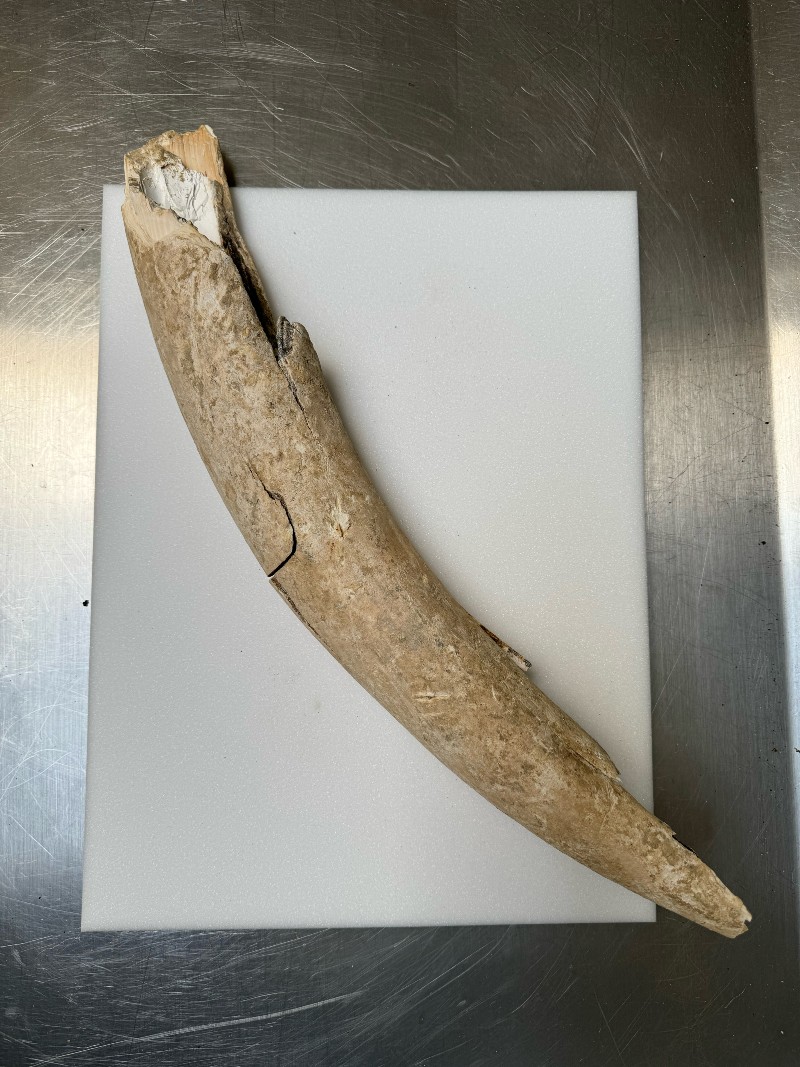Worker finds mammoth tusk in gravel pit in Denmark

A rare mammoth tusk has been found by a machine operator at a gravel pit in Terndrup, north of Aarhus, in the second mammoth find made at the location.
Kristian Lang Hedegaard, a machine operator at the Siem Grusgrav gravel pit in Terndrup, north of Aarhus, was excavating gravel on May 16th when a scoop revealed the tusk.
"I actually had my colleague on the phone when I picked up the scoop, and then I said: 'I think, damn it, that I have found a tusk for the cheekbone we found a few years ago," the machine operator at the pit, which is owned by the bulding company NCC, told TV2.
"We find a lot of sea urchins and things like that out here. But it's more fun to find slightly bigger things. I think it was about five meters down."
Simon Kongshøj Callesen, a palaeontologist and biologist at the Natural History Museum in Aarhus, told TV2 that the gravel deposit was caused by sediment that had bee nwashed there when glaciers melted at the end of the ice age, bringing fossils like the tusk from across Scandinavia.
After it was dug up, the tusk went through a sorting machine, which the museum suspects may have caused some damage, as there appears to be a fresh break on the tusk.
"It is a unique find. Not many such finds have been made in Denmark," Callesen said in a press release. "Now we want to make sure that it does not get any more cracks, and then we will register it, pack it up and hope that someone can use it in a research context, which we are always very open to."
In its press release, the museum says that as Siem Grusgrav was formed from sediment washed away at the end of the Weichsel Ice Age, the last ice age seen in Europe, when woolly mammoths were common, the tusk is likely to come from a mammoth, rather than from one of the straight-tusked elephants who had roamed Europe until the arrival of the ice age largely pushed them out of Europe.
In 2020, NCC workers found a mammoth molar tooth at Siem, which is currently on display near the entrance of the Aarhus National History Musuem.
 The mammoth tusk will be cleaned up and stored for future research. Photo: Aarhus Natural History Museum.
The mammoth tusk will be cleaned up and stored for future research. Photo: Aarhus Natural History Museum.
Comments
See Also
Kristian Lang Hedegaard, a machine operator at the Siem Grusgrav gravel pit in Terndrup, north of Aarhus, was excavating gravel on May 16th when a scoop revealed the tusk.
"I actually had my colleague on the phone when I picked up the scoop, and then I said: 'I think, damn it, that I have found a tusk for the cheekbone we found a few years ago," the machine operator at the pit, which is owned by the bulding company NCC, told TV2.
"We find a lot of sea urchins and things like that out here. But it's more fun to find slightly bigger things. I think it was about five meters down."
Simon Kongshøj Callesen, a palaeontologist and biologist at the Natural History Museum in Aarhus, told TV2 that the gravel deposit was caused by sediment that had bee nwashed there when glaciers melted at the end of the ice age, bringing fossils like the tusk from across Scandinavia.
After it was dug up, the tusk went through a sorting machine, which the museum suspects may have caused some damage, as there appears to be a fresh break on the tusk.
"It is a unique find. Not many such finds have been made in Denmark," Callesen said in a press release. "Now we want to make sure that it does not get any more cracks, and then we will register it, pack it up and hope that someone can use it in a research context, which we are always very open to."
In its press release, the museum says that as Siem Grusgrav was formed from sediment washed away at the end of the Weichsel Ice Age, the last ice age seen in Europe, when woolly mammoths were common, the tusk is likely to come from a mammoth, rather than from one of the straight-tusked elephants who had roamed Europe until the arrival of the ice age largely pushed them out of Europe.
In 2020, NCC workers found a mammoth molar tooth at Siem, which is currently on display near the entrance of the Aarhus National History Musuem.

Join the conversation in our comments section below. Share your own views and experience and if you have a question or suggestion for our journalists then email us at [email protected].
Please keep comments civil, constructive and on topic – and make sure to read our terms of use before getting involved.
Please log in here to leave a comment.